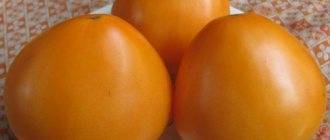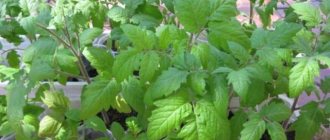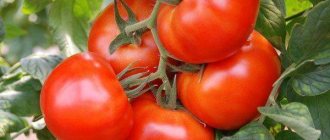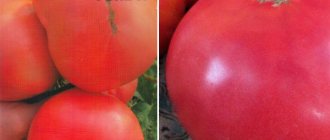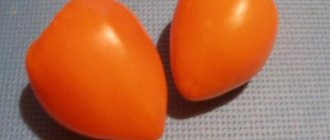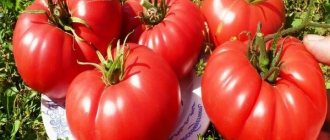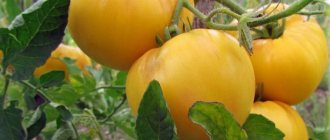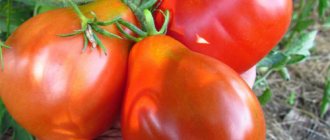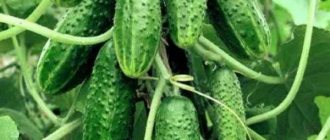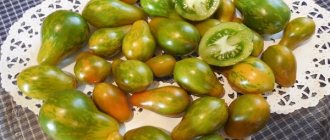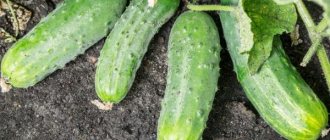The Orange Heart tomato is a hybrid of the famous Bull Heart variety, bred at the beginning of this century in Russia. The variety was originally created for cultivation in the Urals and Siberia. It was included in the State Register in 2003. A characteristic feature of this tomato is its orange fruits. The hybrid can be grown in almost all regions, and both cultivation in greenhouses and in open ground is practiced. The article discusses the description of the Orange Heart tomato variety, its photos and reviews of gardeners who grew it.
Description of tomato
The Orange Heart variety is a tall variety. The height of the stem can reach 2 m when grown in greenhouses and about 1.5 m when the variety is cultivated in open ground. The stem is liana-shaped, about 8 mm thick. This means that the Orange Heart tomato requires tying the stem to a support or trellis. The color of the stem is light green. A view of a young tomato bush Orange Heart is shown in the following photo.
This tomato variety is indeterminate, that is, its growth continues after the formation of the first ovary. Stepchildren are formed actively and frequently. Typically, 2-stem cultivation is used.
The Orange Heart tomato bush is quite large, its foliage is high. This is one of the main differences from its ancestor plant, Oxheart, most varieties of which have weak foliage. Moreover, the leaves are medium in size, have a low degree of dissection and are dark green in color.
The flowers of the tomato hybrid are small in size and light yellow in color. Usually, they are collected in simple racemose inflorescences.
The ripening time for tomatoes in greenhouse conditions is about 100 days, in open ground – about 125 days.
Description of fruits
Consider the description of the Orange Heart tomato fruit. The fruits have a characteristic elongated shape (heart-shaped, which, in fact, is reflected in the name of the variety) with smoothed ribs. The fruit ends with a small rounded point, for which the variety received the unofficial name Liskin Nose.
The weight of the fruit can vary significantly. On one bush there can be fruits weighing from 120 to 300 g, with earlier species having a larger mass.
Tomatoes have a characteristic orange color. In a state of technical ripeness (which occurs on the 90th day from the moment of emergence), they have a small green spot in the area where the stalk is attached. By the time it is fully ripe, it disappears, in addition, the color of the tomatoes becomes deep orange.
The pulp of tomatoes is extremely juicy and meaty. Ripe tomatoes contain increased levels of sugars and pectins. There is a high concentration of B vitamins and antioxidants.
The taste is considered very good, with a subtle fruity aroma. The taste rating is 4.8 on a 5-point scale, which is one of the highest.
Landing
The bushes are planted in a greenhouse once the threat of frost has disappeared. Sowing of seedlings is carried out 55-60 days before. Before sowing, the seeds are checked for germination and treated:
- First, they are poured into salt water and only those that go to the bottom are selected for planting (those that float up, as a rule, turn out to be empty).
- Then prepare a one percent pink solution of potassium permanganate and immerse the grains in it for half an hour.
- Remove and rinse or soak in clean water for another half hour.
- Prepare a solution of a stimulant according to the instructions - for example, the drug Epin, and treat the seeds with it.
- If desired, you can germinate them by placing them on a piece of damp cloth in a saucer with water poured into the bottom so that the seeds do not float, but come into contact with the liquid. In this case, you can plant it when sprouts of 1-2 mm appear.
Add 0.5 parts of sand or sawdust and measure the acidity. If the pH value exceeds 6.5, add wood ash or a few tablespoons of crushed chalk until the acidity decreases. Then fertilize with superphosphate (2 tsp.
per 10 kg of mixture).
Sow the seeds in small furrows, moisten them, cover the boxes with transparent oilcloth and allow them to germinate in a warm place. Then provide the seedlings with 22 degrees during the day and 16-18 at night. Light for at least 16 hours a day, rotate the boxes so that the sun hits the plants evenly.
In the phase of 2 leaves, picking is done. It is convenient to use peat pots, from which you do not need to remove the plants before planting them in the greenhouse.
We invite you to familiarize yourself
Characteristics of tomato
This tomato variety has a very good set of characteristics. We can say that it is one of the most successful hybrids created over the past 20 years. The combination of excellent taste properties of fruits and average ripening times are very attractive to many gardeners.
Productivity and fruiting
If agricultural practices are followed correctly, the Orange Heart tomato can produce abundant harvests. In open ground, the yield is up to 2 kg per bush, when grown in greenhouses - more than 4 kg per bush. Planting both in open ground and in greenhouses is recommended in 2 rows with a distance between plants of 50 cm, and between rows of 40 cm. At the same time, given the high foliage of the plant and the large size of the bushes, it is not recommended to plant more than 2-3 plants per 1 sq. . m. Thus, the yield, depending on the method of cultivation and planting density, can range from 4 to 12 kg per square meter. m area.
These are ideal indicators; in reality, the results are a little more modest. According to reviews from gardeners, the yield of Orange Heart tomatoes is about 8-10 kg per 1 sq. m area; The typical appearance and size of the fruit is shown in the photo below.
The ripening time in the greenhouse is about 3 months. Officially, the time is 90-95 days, however, technical ripeness occurs approximately a week and a half before complete ripeness. In open ground they are extended for another 1 month (from 120 to 135 days).
The main factor affecting yield is the way the plant is grown. When using single-stem agricultural technology, the yield will be low: it is unlikely that you will be able to remove more than 2 kg from a bush during greenhouse cultivation. Growing an Orange Heart tomato with 3 stems is quite problematic technically, given the high density of the bush.
Therefore, double-stem cultivation is used. It is this that allows you to maintain a balance in the number of bushes per unit area and ensure maximum yield per 1 square meter. m.
Area of application of fruits
The fruits of the Orange Heart tomato variety are used mainly fresh. They are used to prepare first and second courses, in particular, hot and cold soups, side dishes, and sauces. In salads, thanks to its excellent taste, this variety has virtually no equal. Tomatoes have proven themselves very well in making juice.
Due to the absence of red coloring pigment, which is a strong allergen, orange tomatoes are considered an almost hypoallergenic product and are recommended for baby food.
Due to its dense structure and fairly durable skin, the fruits of this tomato variety have good keeping quality and transportability.
However, this variety is practically not suitable for preservation. Prolonged heat treatment and stay in the marinade significantly worsen the consistency of the pulp and its taste: it becomes fibrous and sour.
Resistance to diseases and pests
The Orange Heart tomato is highly resistant to the following diseases:
- late blight;
- bacteriosis;
- hide the rot;
- mosaic.
However, we should not forget about preventive measures that have approximately the same sequence of actions for most tomato diseases.
It should also be noted that the Orange Heart tomato has relatively good resistance to aphids and mites.
Advantages and disadvantages of the variety
Summarizing the description and characteristics of the Orange Heart tomato variety, we can say that it has the following advantages:
- excellent taste;
- increased content of useful elements in the pulp;
- absence of allergens;
- high productivity;
- unpretentiousness in cultivation - the variety is recommended for cultivation in a wide variety of climatic conditions;
- good resistance to major tomato diseases and pests;
- high shelf life and transportability.
The disadvantages of the variety are:
- relative difficulty in forming a bush due to active pinching;
- the impossibility of obtaining your own seed, since the variety is actually a hybrid.
Important!
The variety is capable of producing seeds. These seeds are capable of bearing fruit, but the quality of the material will leave much to be desired. Tomatoes obtained from such plants will be small, tasteless and have a wide variety of colors and shapes.
Agricultural technology of tomatoes Orange heart
Orange heart is grown in open and protected ground. In cold regions, option 2 is preferable.
Tomatoes are planted when the soil warms up. March is considered the optimal time for picking. In the southern regions, planting is possible at the end of April, and in the northern regions - at the beginning of June.
Before picking, tomatoes need to be prepared. To do this, 3 days before the procedure, the plants are watered and fed.
Landing rules
The beds for tomatoes are prepared in advance. In the fall, the soil is dug up and cleared of weeds, after which it is enriched with mullein, ash and lime. In the spring, the soil is dug up again and watered with a solution of copper sulfate.
For tomatoes, dig holes in rows. For 1 sq. m place 2-3 plants. 1 tablespoon of ash is poured into each cavity.
The seedlings are carefully removed from the pots. It is placed in the holes in the center. The depressions are filled with water and covered with soil. The next watering after planting the seedlings is possible no earlier than 2 weeks later.
How to care for a tomato
Bushes of the Orange Heart variety need a garter. The support chosen is strong and high. This can be a wooden peg or trellis.
The plant is formed into 2 or 3 stems. The more stems, the slower the harvest will ripen and the smaller the fruits will be.
Regularly remove the lower leaves and excess tomato shoots. This procedure is carried out in the morning or evening on clear days.
The soil is moistened as it dries
It is important to consider that in dry weather or high humidity the fruits crack
Fertilize tomatoes 3-4 times per season. Gardeners recommend alternating mineral complex fertilizers and manure. Foliar feeding with boron will help the ovaries form faster.
The nuances of growing tomatoes Orange Heart
Orange heart is an unpretentious variety. It is undemanding when it comes to fertilizing, and by following the basic rules, even novice gardeners can successfully grow it.
When pinching, it is important to remove the entire body of the shoot. If the stepson is not completely removed, the likelihood of the plant becoming infected will greatly increase.
Diseases and harmful insects
Tomato Orange Heart is immune to viral and fungal diseases. However, it is affected by late blight.
To avoid tomato diseases, follow the rules for caring for them. Do not over-moisten or over-dry the soil. Such conditions are ideal for the development of pathogens.
It is necessary to disinfect not only the soil and planting material. All garden tools that will interact with tomatoes must undergo a disinfection procedure. They may contain fungi and viruses.
To prevent late blight, plants are sprayed with copper preparations. Another method is spraying with a solution of potassium permanganate.
It is important to protect plants from harmful insects. They not only spoil the bushes themselves, but also infect them with fungi and viruses. Thrips, whitefly and spider mites are afraid of celandine infusion
Slugs are repelled by a solution of ammonia. To get rid of aphids, use a soap solution. The above-ground parts of the plant are sprayed with this product.
Thrips, whiteflies and spider mites are afraid of celandine infusion. Slugs are repelled by a solution of ammonia. To get rid of aphids, use a soap solution. The above-ground parts of the plant are sprayed with this product.
Growing rules
Growing Orange Heart tomatoes is almost exactly the same as growing any other variety, but there are some nuances. In particular, this concerns the issues of forming a bush and maintaining it in the required shape. However, this is typical for many indeterminate varieties of tomatoes.
Important! To obtain a good harvest from plants that have a high tasting rating, correct crop rotation is required.
Good predecessors of the Orange Heart tomato are representatives of cruciferous vegetables, as well as cucumbers, herbs and carrots. It is highly undesirable to plant tomatoes after any nightshade crops (potatoes, other tomatoes) or legumes.
Planting seedlings
Taking into account the timing of fruiting, planting of Orange Heart tomato seedlings should be done at the end of February or at the beginning of March when grown in greenhouses. The planting dates are shifted 2-3 weeks later if you plan to plant the Orange Heart tomato in open ground.
For normal development of the Orange Heart tomato, it should be planted in open ground approximately two months after planting. It is highly undesirable to keep seedlings in pots. On the other hand, it is necessary that the temperature of the top layer of soil is not lower than + 18 °C. Therefore, when choosing the timing of planting seedlings, you should take into account the features of the local climate and adjust the time of planting seeds taking into account these features.
Preparing for planting seeds involves standard procedures, not much different from other varieties of tomatoes.
For soil, you can choose a ready-made mixture for seedlings or make it yourself from a mixture of garden soil and peat, which are taken in a ratio of 50% to 50%. Sometimes the mixture may consist of 3 components mixed in equal proportions: soil, peat and sand. As such, the composition for seedlings does not play a role in this case, since when growing the Orange Heart tomato variety, fertilizing will be used.
Before planting, the soil can be disinfected using a solution of potassium permanganate, or by calcining it for half an hour in the oven at a temperature of + 100-110 ° C. In the latter case, the soil needs to sit under a layer of gauze for 1 to 2 weeks to restore the microflora.
It is also advisable to treat the seeds immediately before planting with an antiseptic, which can be the same potassium permanganate or copper sulfate solution (concentration 0.1-0.2% and 1%, respectively). The seeds are immersed in the solution for 3-5 minutes, after which they must be dried and only then planted. You can speed up the seed drying process using a regular hairdryer, without raising the temperature of the warm air above + 40 °C.
For containers, you should take several dozen individual pots (peat or plastic) with a diameter of at least 8 cm, since the seedlings can be quite spreading. It is not advisable to use one large box for seedlings, so as not to injure the root system of the plant during replanting. In addition, such planting allows plants to be individually transferred to different conditions to ensure their uniform growth and saves the gardener from such a tedious process as picking.
The pots are filled with 80% soil, a 1.5-2 cm depression is made in the center of the pot, 1-2 seeds are placed in it, sprinkled with soil and watered.
After watering, the seedlings are covered with plastic film or glass and sent to a warm place without lighting. In about a week the seeds will sprout; at the same time, remove the film from the seedlings and place the pots on the windowsill of the south window, since Orange Heart tomatoes need a lot of light. In mid-spring, the sun may not be enough; seedlings should be additionally illuminated with fluorescent lamps for 3-5 hours a day.
Caring for seedlings includes daily watering with warm water. To prevent plants from being washed out of the soil, it is best to water with a spray bottle.
Picking seedlings is done a month after planting. In the case of growing in an individual container, instead of picking, the weaker plant of the two planted will be pinched.
After this, the first fertilizing of the seedlings should be made in the form of a special complex fertilizer for young plants, which contains an increased concentration of nitrogen fertilizers to improve the growth of green mass.
The second feeding is carried out approximately 10 days before planting the Orange Heart tomato in the greenhouse/open ground (at the beginning or end of May, respectively). However, phosphorus-potassium fertilizers, necessary to strengthen the root system, should prevail in it.
Tomato transplant
Transplantation into a greenhouse or open ground is carried out 60-65 days from the moment the first shoots peck (mid or late May, respectively). This procedure for Orange Heart is also not much different from other tomatoes. Varietal differences lie only in the recommended planting pattern.
For the Orange Heart variety, the planting pattern is 50 cm between bushes and 40 cm between rows when grown in greenhouses and 60 cm/50 cm when planted in open ground. Both in greenhouses and in open ground, two-row cultivation of tomatoes is mainly used.
Important! The distance between the beds should be 80 cm or more, since each bush must be provided with free access to be able to form and tie it up.
The depth of the holes for transplanting the Orange Heart tomato is 15 cm. Approximately half of them should be sprinkled with organic fertilizer - rotted manure or compost. Next, a young plant with a lump of earth is placed in the hole, the hole is filled with soil, lightly compacted and watered with 3-5 liters of water.
Important! It is advisable to transplant plants to a permanent place in the garden or greenhouse in cloudy weather or in the evening.
Subsequent care for tomatoes
Subsequent care for tomatoes is standard and includes watering, fertilizing, loosening the soil and forming a plant bush. All procedures, except the last one, are the same for any other variety of tomatoes:
- Watering is carried out once every 3-4 days with warm, settled water. It should be carried out directly under the root, without wetting the leaves.
- After each watering, you should loosen the soil to a depth of 2-3 cm. If mulch is used, this is not necessary.
- Adult plants should be fed 3-4 times during the season. It is recommended to alternate between root and foliar feeding. It is recommended to stop the latter after the first green fruits appear. It is best to use complex fertilizers, each time closer to maturity, using formulations with less nitrogen.
As for the formation of the bush, the Orange Heart variety has some features. A tomato produces the greatest yields when it is formed into two stems. This means that when forming an Orange Heart bush, you should remove all the lower leaves and all the stepsons, leaving only one of them, located under the first flower cluster.
Liana-like stems of great length (1.5-2.0 m, depending on growing conditions) require garters at several points to supports or trellises. It is also advisable to tie up large bunches of fruit.
Agricultural technology of the “Orange Heart” variety
Sowing begins at the end of February and until mid-March. You can buy ready-made soil right away, you can use the simplest recipe - humus and soil from the garden in equal parts. But here it is better to take soil after such predecessors as cabbage, cucumbers, legumes, onions, herbs, but not from where tomatoes and potatoes grew. Otherwise, there is a high risk of contracting the disease.
So, to give your future seedlings more strength and immunity, it is better to soak the seeds in a manganese solution. Then, before planting, place the seed material in a growth stimulator - “Heteroauxin”, “Epin Extra”, “Kornevin”. Next, you can sow the seeds in boxes without deepening them more than 1.5 cm. The distance between the seeds is approximately 1-1.5 cm. Then you moisten the soil and cover it with film before the seedlings sprout. In the phase of 2-3 leaves, they are picked into separate pots; it is better to take peat ones.
Further, care is simple - watering, but only as it dries, you can add the complex preparation once, if you have not added anything to the soil before or bought ready-made nutrient soil. The transfer will be outside in early June, and into the greenhouse in May. Before going outside, it is better to harden the seedlings 14 days in advance. After transfer, it is better to insulate the seedlings with film for the first days.
Planting is carried out in the ground after first treating it with boiling water and adding a spoonful of mineral fertilizer. Water for watering young seedlings should be warm. It is better to form and tie up bushes right away. To make two stems, remove all the stepsons and lower leaves up to the upper axil, here one stepson is torn off, the second one is left. It is also worth noting that it is better not to plant more than 2-3 bushes per meter.
To prevent rot from affecting your tomatoes, the plantings must be treated with copper-containing preparations; you can also use a weak solution of manganese for spraying. Be sure to ensure that there is no stagnation of moisture; always ventilate the greenhouse. Infusions of celandine, soapy water, infusions of weeds and pepper help against pests. If there are slugs, you can fight them with a weak solution of ammonia.
As for feeding, 3-4 times will be enough; you can alternate the drug from the store, where there is a complex of minerals with mullein solution. Tomatoes love chicken droppings and manure. Be sure to first dilute the fertilizer in a large amount of water and infuse it. Seedlings are watered in the evening. Also remember about loosening and removing weeds.
That's all the agricultural technology for the Orange Heart tomato. Everything is quite simple. You can cope even without much experience.
Pest and disease control
Despite the plant’s high resistance to major tomato diseases, preventive measures will not be superfluous. The main problems of all nightshades are fungal diseases and invasions of insects specializing in this family (Colorado beetles, wireworms, aphids, etc.). It is on the prevention of these problems that you should focus when growing Orange Heart tomatoes.
Preventive measures include regular ventilation of the greenhouse, treating the soil with preparations containing copper (for example, Bordeaux mixture or copper sulfate), moderate watering without stagnating moisture, etc.
Mulching with freshly cut grass will help protect the plant from about half of potential pests; If you cover the free soil with agrofibre, then the likelihood of a plant being attacked by a wireworm or Colorado potato beetle is reduced to almost zero.
You can fight aphids with a warm soapy solution, and slugs with a 10% ammonia solution.
Resistance to diseases and adverse conditions
Although the plant varieties are resistant to diseases and pests, prevention will not be superfluous. Ventilation and cultivation of the soil with the removal of weeds will help in the fight against late blight. The more often you do this, the better. Plants will benefit from watering, controlling moisture stagnation. It is also better not to plant tomatoes next to potato and eggplant beds.
Important! To protect tomatoes from the harmful effects of late blight, they must be treated with a decoction of garlic or an infusion of fermented mushrooms. It is also allowed to use special store-bought products. Industrial preparations or an infusion of celandine will help free the plant from insect pests, namely whiteflies, thrips, and spider mites.
Ammonia will help against slugs. Warm water with the addition of laundry soap works effectively against aphids. By following the recommendations described, you will get an excellent harvest of tomatoes.
Industrial preparations or an infusion of celandine will help free the plant from insect pests, namely whiteflies, thrips, and spider mites. Ammonia will help against slugs. Warm water with the addition of laundry soap works effectively against aphids. By following the recommendations described, you will get an excellent harvest of tomatoes.
Growing regions
The variety "Bull's Heart Orange" is suitable for cultivation in almost all regions of the Russian Federation, except the northern ones. But the southern part of the country is better suited for open cultivation, and in the middle part it is better to use greenhouses.
The main purpose of the variety
Tomatoes are not intended for long-term storage. Given the size of the fruit, it is problematic to use for canning. Most often, tomatoes are eaten fresh, added to salads. It is also suitable for making soups, purees, sauces and tomato pastes. Tomato juice from this variety is very tasty. It comes out rich, thick and very aromatic. You can drink the juice freshly prepared or can also preserve it.
Treat seeds with a growth stimulant
| Stage 1. Purchasing or collecting seeds |
Option 1: If you are growing this variety for the first time, buy seeds from a reputable store. It is best if the packaging indicates that the planting material complies with GOST.
Option 2: After the first harvest, select a few ripe fruits, cut them in half and squeeze out the seeds. Then separate them from the pieces of pulp and rinse with water. Dry in the sun
Stage 2. Disinfection
Step 1. Prepare a solution of potassium permanganate, as in the photo. With its help, seed producers advise treating the material against infections.
Step 2. Dip the seeds into the liquid and let sit for 15-20 minutes. Then rinse in warm water
Stage 3. Treatment with a growth stimulator
Step 1. Purchase any growth stimulant. Epin is the most popular among gardeners.
Step 2. Prepare the solution according to the instructions. Dip the seeds into it and wait the required time
Stage 4. Sowing seeds
Step 1. Prepare a container of a suitable size and fill it with soil for seedlings. The recommended time for work is mid-March.
Step 2. Plant the seeds to a depth of no more than 10 mm. Pour through a sieve and place in a warm place. After germination, move it to the windowsill
Stage 5. Picking
Step 1. After two or more true leaves appear, transplant the tomatoes into separate containers and carefully remove them so as not to damage the root system.
Step 2. Pinch the central root so that the lateral shoots grow better.
Stage 6. Caring for seedlings
Step 1. Spray the plants with warm water in the morning and evening. Water about once a week.
Step 2: Fertilize your seedlings at least once a month.
Step 3. Start hardening 2 weeks before planting. Open the window for 3-4 hours or take the tomatoes outside
How to grow seedlings
Seeds are sown two months before transplanting plants into open ground.
Seed preparation
The seeds are prepared and sowing begins. Taking care of the seeds will speed up germination and protect the plants from diseases.
Preparation of planting seeds:
- All seeds are examined, those capable of germinating are selected, blackened and damaged ones are removed. An easier way: add a little salt to the water and soak the seeds for thirty minutes. Spoiled seeds float to the surface.
- To prevent diseases, they are treated with a disinfecting solution. Use the product of your choice: hydrogen peroxide or potassium permanganate. The seeds are soaked in the chosen product for two hours, and then thoroughly washed with water.
- For early germination, soak for 12 hours in a growth stimulator. Such drugs (for example, Epin) are sold in all specialized stores for summer residents.
Container and soil
Sow the seeds in a container of sufficient size. Use trays and boxes purchased at the store, or make the pots yourself. When growing several bushes, the seeds are sown immediately in a pot. When the plant has grown, it is picked and transplanted into a separate container, which must be at least 300 g.
Choose light soils. There is a large selection of soil in stores, but it is cheaper to prepare the soil mixture yourself. Take peat, turf and humus in equal proportions. With this composition the soil will be nutritious and light.
We recommend disinfecting not only the seeds, but also the soil and containers. The earth is calcined in the oven and watered with a solution of potassium permanganate. Containers are sterilized using alcohol or high temperatures, and the container is also wiped with hydrogen peroxide and potassium permanganate.
